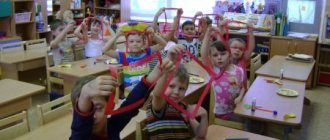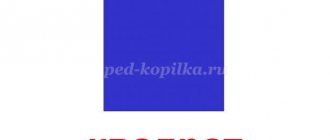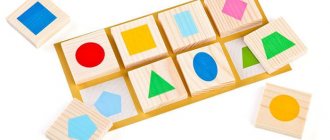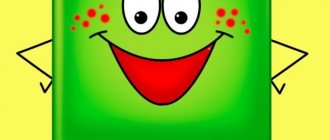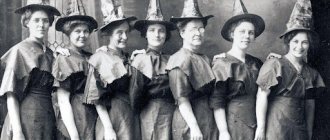Summary of GCD in the preparatory group in mathematics. Geometric figures
Abstract of the educational activity "An entertaining journey to the land of Mathematics" in the preparatory group.
Author: Olga Vyacheslavovna Varlamova, teacher of MKDOU “Gavrilovo-Posad kindergarten No. 1” Description: the lesson was built taking into account the Federal State Educational Standard, using game technology and active learning methods. Goal: Generalization of acquired knowledge. Program content: Training objectives: - to develop computing skills; - exercise children in forward and backward counting within 10; - practice establishing equality between numbers; - consolidate the ability to distinguish and correctly name geometric shapes. Developmental tasks: - create conditions for the development of logical thinking, intelligence, attention; - develop imagination, ingenuity, visual memory; - contribute to the formation of mental operations, speech development, and the ability to argue one’s statements. Educational objectives: - to cultivate interest in mathematical knowledge; - develop the ability to understand a learning task and carry it out independently. Demonstration material: balloon, letter, letters, names of stations, geometric shapes. Handouts: cards with numbers, squared pieces of paper, pens. Methodical techniques: - game (surprise moment); - verbal (reading a letter, questions, conversation, logical tasks); — visual (demonstration material); - lesson analysis, encouragement. GCD move: A ball with a letter flies into the group. The children notice the ball and gather around it. Educator: Guys, where did this ball come from? Who could give us such a surprise? (During the discussion we find out that the postman brought it). -Let's see what kind of letter this is, maybe we'll learn something interesting from it. (I unfold the letter) - It was written by a Fairy from the country of “Mathematics”.
Guys, who can read here? (I ask a child who can read to read the letter). “Dear guys, I invite you to go on a trip to the land of Mathematics, where I have prepared various tasks for you. You will need to add, subtract, compare, solve fun problems, think and reflect. For each completed task you will receive a letter. Then make a word from these letters. These tasks are for smart and resourceful children! Fairy from the Land of Mathematics." Educator: Guys, do you agree to go on a trip? Aren't you afraid of difficulties? Do you love to travel? What do you think you can travel with? (children's answers). - I like to travel too! We'll go by train.
What do you need to buy for a train trip? (tickets) - Dear passengers! Take your tickets and take your seats in the carriages. Have you noticed that the tickets are unusual? How do you know what your place is? (tickets are cards with written examples of addition and subtraction, and on the chairs are cards with answers). - Certainly. An example needs to be solved. (Children solve examples and find their places. Children who find it difficult are helped by other children). - Guys, look at each other, are you in the right place? But before our train sets off on its journey, let's remember: - how many days are there in a week? - name them; — what day of the week is it today? - what number is he? - What day of the week was yesterday? - What day of the week will it be tomorrow? - Well done! Go! The song “We are going, going, going to distant lands” is playing
- Attention!
Attention! Stop! Guys, let's read the name of the station? (children read) “Warm-up” Game: “Question and answer.” Questions: - serial counting up to 10; - count down from 10; - counting from 1 to 10; - counting from 4 to 9, from 7 to 2, from 9 to 3; - name the neighbors of the numbers 5, 3, 6, 8; - name the previous number of numbers 8, 2, 6; - name the next number of numbers 3, 5, 7. - You completed the task, you get a letter. What letter is this? (children's answers). - That's right, the letter M. Let's continue our journey! Take your seats! Go! The song “We are going, going, going to distant lands” sounds
- We have arrived!
Let's read the name of the station. (Children read). "Counting". Fill in the blanks by inserting the missing character or number. 3+5 8, 8 1=7, 2 2=4, 7 2=5, 10-3 7, 4+4 8, 6 4 10, 4 3 1. You did a great job with this task too! Get a letter! What letter is this? (children's answers). – That’s right, letter O. Let’s continue our journey! Take your seats! Go! A song is playing.
- We've arrived!
What kind of station is this? (Children read). "Geometric". Logical problem “Which figure is the odd one in the row?” You did a good job with this task too! Here's a letter for you! (Children name the letter) - That's right, the letter L. And our journey continues! Take your seats! Go! A song plays and the children sing along.
- We've arrived!
What kind of station is this? (Children read). "Jokes are riddles." Task "Logic puzzles". Be careful and you will definitely cope with them. 1. How many ears do three mice have? (6) 2. How many paws do two bear cubs have? (8) 3. What is lighter than 1 kg of cotton wool or 1 kg of honey? (weight is the same) 4. Two willows grew, on each willow there were two branches, on each branch there were two pears. How many pears are there in total? (Not at all. Pears don’t grow on willows). “You did a good job, here’s your letter.” (Children name the letter). Letter O. Now you can relax. Physical education minute. We've done some work, guys, and now let's all get exercise! Now we will all get up together, we will rest at the rest stop. Turn left, turn right, bend over, rise up. Hands up and hands to the side, And jump and jump on the spot! And now let’s skip and run, Well done, kids! Let's slow down, children, and stand still! Like this! And now we will sit down together, We still need to work. - Take your seats on the train! Go! A song is playing.
- We've arrived!
What kind of station is this? (Children read). “Take a guess.” Compare the numbers and put the appropriate equal or inequality sign. 2 5, 4 4, 3 1, 7 7, 9 10, 5 5, 8 6. Place cards with numbers in pairs so that the sum of each pair results in the number 10. 1 and 9, 2 and 8, 3 and 7, 4 and 6, 5 and 5, 6 and 4, 7 and 3, 8 and 2, 9 and 1. - For a completed task you receive a letter. What letter is this? (D) Take your seats on the train! Let's move on! A song is playing.
- We've arrived!
What kind of station is this? (Children read). "Graphic". Here we will do a mathematical dictation. From the point to the right 2 cells, Up 1 cell, Right 1 cell, Up 1 cell, Right 1 cell, Down 4 cells, Right 3 cells, Up 1 cell, Right 1 cell, Down 5 cells, Left 2 cells, Up 1 cell, Left 2 cells, Down 1 cell, Left 2 cells, Up 4 cells, Left 2 cells, Up 2 cells. - What did we do? (Dog) . For completing a task you receive a letter. What letter is this? (C) Take your seats on the train! Let's move on! A song is playing.
- We've arrived!
What kind of station is this? (Children read). "The ultimate." Solve the rebus: 4 3 2 5 1 T R A A P Having guessed the word PARTA correctly, children receive the letter Y. - Guys, you completed all the tasks! For each task you received letters. Let's read what kind of word we got. - Well, it’s time for us to return. Take your seats on the train. A song plays and the children sing along.
Educator: Guys, here we are in kindergarten. Did you enjoy our trip? Were the tasks difficult? Would you still like to travel to the land of Mathematics? (children's answers) And for good knowledge, the Fairy of the Country of Mathematics left you a gift, medals. Presentation of medals. Thank you for your attention!
We recommend watching:
Abstract of GCD in mathematics in the preparatory group. Counting to 20 Summary of direct educational activities in mathematics for children preparatory to school. Notes of GCD on FEMP in kindergarten. Preparatory group Math lesson in kindergarten. Preparatory group
Similar articles:
Summary of mathematics lessons in the preparatory group. Pentagon
Abstract of GCD in mathematics in the preparatory group. Solving logical problems
Abstract of GCD in mathematics in the preparatory group on the topic: Area
Abstract of GCD in mathematics in the preparatory group. Tangram
Abstract of GCD in mathematics in the preparatory group. Ruler, clock dial
Purpose of the lesson
Fix the names of geometric shapes: “triangle”, “square”, “rectangle”, “quadrangle”; learn to classify figures according to different criteria: size, color, shape; practice counting within 10; learn to name a word that is opposite in meaning to the one suggested.
Materials
For the teacher: ball.
For children: a set of geometric shapes of different colors, sizes, shapes (20 pcs.).
Progress of the lesson
Sitting at the table
There are geometric shapes on the tables in front of the children. The teacher asks the children to name them and gives tasks.
Set aside all the circles. What are they in size and color?
Set aside the green pieces. What shape are they? How many are there?
Set aside the quadrangles. Call them differently. Tell me, how many different quadrilaterals are there?
Set aside all the shapes except the triangles. What shape are they?
Set aside the yellow little shapes. What shape are they? Let's play
Games can be played both indoors and on the site.
"Count on"
Children form a circle. The teacher stands in the center of the circle. He's bro-
throws a ball to one of the children and calls any number. The child who catches the ball calls the next 2-3 numbers and returns the ball to the teacher. Now the teacher throws the ball to another child and the game continues.
A variation of the game could be the “Before and After” game. The teacher throws the ball to the child and says: “Count to five.” The child must name the numbers that go up to five: one, two, three, four.
If the teacher says: “After five,” the children must name the numbers: six, seven, eight... The game takes place at a fast pace.
"Vice versa"
The game takes place in a circle. The teacher stands in the center of the circle, throws the ball to one of the children and says the word. The child must say a word that has the opposite meaning. The teacher says: “Forward.” The child answers: “Back.” (Right - left, up - down, far - close, inside - outside, etc.)
Making the game more difficult. You can name not only adverbs, but also adjectives: far - close, upper - lower, right - left, deep - shallow, cheap - expensive, etc.
If the child finds it difficult to answer, the children say the right word in unison.
On a walk
Draw children's attention to the changes that occur in nature in autumn. Find out what time of year and month it is. Ask what month September is (ninth), ask the children to name all the months.
Remind us of the proverbs about autumn.
tt In September there is one berry, and even that bitter rowan.
te September is cold, but full.
tit In September, summer ends and autumn begins.
Tips for a teacher
Don’t forget to tear off a piece of the calendar for the past day every morning with your children. Ask your children what day of the week it was yesterday and what day it is today. Invite the children to name today's date and month. Think back to the summer months.
At the beginning of the school year, it is necessary to conduct an individual interview with each child within two weeks. The purpose of the interview is to identify children’s knowledge, skills and abilities in mathematics. Enter the results of the interview in the table. The contents of the interview and the methodology are given at the end of the book.
Tell parents that over the next two weeks, conversations will be held with children that will reveal their mathematical understanding and ability to operate with them.
Math games with geometric shapes for children 5-7 years old
Games with geometric material to recreate silhouette figures for children of senior preschool age
Author: Nadezhda Vladimirovna Ryabichenko, primary school teacher at the Mikhailovskaya Secondary School, Kikvidzensky district, Volgograd region Brief description: This game can be used in working with children 5-7 years old. To play, you need to take a square, making it from cardboard, plastic or other materials, and cut it along the lines into different shapes. There will be 11 shapes in total: two squares, four triangles, one large quadrilateral and four small quadrilaterals. When composing silhouette figures, all parts are used that are attached to one another, but do not overlap each other. It is possible to use this game with children 3-4 years old, using samples of already composed silhouette figures. Goal: developing the ability to create silhouette figures from polygons. Objectives: - consolidate children’s knowledge about geometric figures; - develop cognitive interest, independence, intelligence, observation, logical thinking, the ability to creatively search, the ability to find new ways to solve a given problem. I offer a square template, which you can increase or decrease if you wish. It doesn’t have to be the same size as mine (that’s why I don’t indicate the dimensions of the square itself).
First, you can look at the square with your children and find out what figures it consists of by asking riddles: Look at this figure: It has only three angles. You are probably ready to name it by the number of angles. (triangle)
I have three sides, I have three angles.
You will quickly call me, I know this. After all, every schoolchild knows, Me - I... (triangle)
I am a figure - no matter where, I am always very even, All angles in me are equal And four sides.
The cube is my beloved brother, Because I... (square)
Not a triangle or a circle, And I’m not a friend to the oval.
I am the brother of the rectangle, After all, my name is... (square)
I have four corners, like a square, But I don’t dare call myself a square, And yet, it looks like a square, by the way, Two long sides, two shorter.
(quadrangle)
We stretched the square and presented it to the eye, Who did it look like Or something very similar?
Not a brick, not a triangle - Became a square... (quadrangle)
Examples of composing figures:
Cow
Giraffe
Envelope
Dog
Tower
I made the game using the DragAndDrop template.
This macro was created by programmer Hans Hofmann (Germany). Working with the DragAndDrop template. 1. Open the program. 2. Click Slide Show
, select
From Beginning
or
From Current Slide
.
3. In the Security Alert
select
Enable this content
, then click
OK
.
4. When creating silhouette figures on a slide, you need to left-click on any figure once , move it to the desired location, and left-click again. We move all the figures in the same way. If a child has difficulty completing a task on his own, he can use a hint. When you click on the word hint, a picture with an image appears in the upper left corner of the slide. When you click on any shape, the hint picture closes. The hint can be used an unlimited number of times.
To create the next silhouette you need to go to the next slide. After completing the task, you can save your work, but it’s better to click “don’t save.” The games can be used by elementary school teachers at extracurricular mathematics events with students in grades 1 and 2, as well as by kindergarten teachers during classes with preschoolers. Parents can use this development to organize their children’s leisure time.
Presentation on the topic: Mathematical games with geometric shapes
We recommend watching:
Mathematical games with Cuisenaire sticks for children 6-7 years old Mathematical fairy tale - a game for children of the preparatory group of preschool educational institutions Didactic games in mathematics for children 4-6 years old Mathematical game in kindergarten for preschoolers with learning difficulties
Similar articles:
Exercises with counting sticks for preschoolers
Math problems jokes for preschoolers
Mathematical riddles for preschoolers in verse with answers
Games for the development of elementary mathematical concepts in preschoolers 3-5 years old
Games with geometric shapes for children 4-6 years old
Learning geometric shapes with kids in preschool educational institutions
When studying geometric concepts, children also gain other knowledge and skills in parallel:
- they learn to think logically;
- get the opportunity to develop knowledge of the Russian language;
- the perception of space and the ability to navigate in it improves;
- children develop fine motor skills;
- Intellectual qualities develop: the ability to make comparisons, analyze, and generalize.
Note! When teaching in kindergarten, the development of geometric concepts is not highlighted as a separate topic, but occurs in combination with other topics.
Children learn geometry
Learning colors and shapes for children from 2 years old
Geometry learning should begin with the simplest figures; more complex ones should be left for subsequent years. It is believed that children are able to perceive shape on a subconscious level within six months after birth. At this time, the main way of teaching is through mention during the story. When showing pictures, you can casually notice that the objects depicted have a certain shape.
When teaching, you need to take into account that kids can only learn to distinguish between the simplest ones: circle, square and triangle.
Note! Studying in a year or two or three should be easy and fun. For mastering it is convenient to use three-dimensional figures. Studying, for example, a circle, you can imagine that he came to visit the baby. You can use your child's finger to trace a circle along the outline. You can make such an applique, decorating it with eyes and a nose.
Calendar plan in the preparatory group for each day according to the Federal State Educational Standard
A child can play with this item: make a tower by placing one on top of the other, throw it to the side or put it in a box.
This integrated approach to a geometric design project is very effective for toddlers, but for younger children it can be considered the primary way to learn shapes.
For children under two years of age, the following may be used:
- children's ability to compare objects;
- use a children's educational set, where you need to select a hole of a suitable shape and size for the figurine.
A two-year-old child is able to choose the appropriate shape from a set.
When they teach figures to 3-year-old children, they can already show the one that was named by the teacher.
Learning figures for children 3 years old
When teaching children geometric shapes, it is important to consolidate familiarity with the material that they have previously learned. We need to continue studying and move on to those that are more difficult to understand - oval, rhombus and rectangle.
When teaching children, you can show children examples of figures, letters of the alphabet and compare them with other objects in shape and size.
Important! During the walk, children are told about the objects they see, mentioning their shape and simple geometric properties.
An important role when teaching geometric shapes to children is played by creative activities, when children draw or sculpt samples and put them together from a given set of component parts.
Using cards depicting complex objects, the child is asked to talk about the components in the form of certain shapes.
Children education poster
Geometric shapes in the senior group
At this time, the lessons move on to considering new, more difficult to understand figures, repeating those that they should have known before.
In classes at the age of five, children are asked to consider and talk about their common and different properties. For example, questions are asked about where open figures have corners and in which cases they do not.
They try to teach children to analyze the complex shapes of real objects, to find elements in them that have the form of simple figures. They learn about more complex shapes, such as a cone.
Geometric shapes in the preparatory group
At this age, children have already mastered the basics of understanding the shapes of objects. At this stage, it is important to develop knowledge and make it more systematic. At this age, children develop a foundation for schooling.
Note! Children in the preparatory group, when introduced to polygons, are told about their sides and angles, and are taught to find the desired figure using a description.
Here is an example of an educational game that can be included in a lesson note and used for teaching. Children are given a set of figures. The player places one of them. Another should put next to it one that differs in only one attribute. For example, if one offers a large blue square, then the other may lay out a small blue square, a large yellow square, or a large blue circle.
The teacher tells the children about the figures
